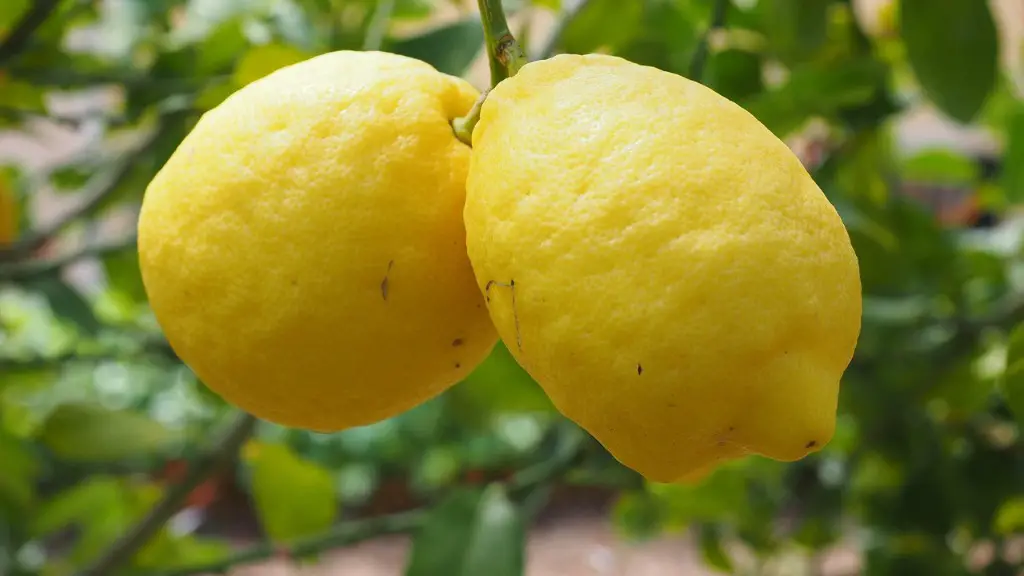Knowing how to help a lemon tree produce fruit correctly is essential for farmers and gardeners alike. A tree that’s healthy and properly nourished will bear more and larger lemons. To ensure optimal performance, fertilization, pruning, watering and temperature control should be taken into consideration.
It’s important to fertilize a lemon tree at the start of the growing season. Organic fertilizer is best, because it’ll last longer and add nutrients to the soil. A balanced fertilizer should be applied in spring and midsummer. Apply a side-dressing of fertilizer every two to three months for optimal growth.
Pruning is necessary for a lemon tree to help it bear fruits. Prune about one-third of the total growth at one time. Prune any broken or dead limbs, as well as any crossing branches. Remove any shoots that emerge from the rootstock. Get rid of any water sprouts or suckers at the base.
Watering is another crucial aspect of producing lemons. During the growing season, the soil should be moist, but not wet. Water the tree deeply once a week. Don’t water too much or too often, as this can overwhelm the plant and cause root damage.
Temperature control is also important for a lemon tree. It should not experience any temperature extremes, as it needs a steady environment. Make sure the tree is in an area that will have warm temperature during the day and cooler temperature at night.
Finally, watch out for pests and diseases. Pests such as aphids and mites can damage a tree and reduce fruit production. To keep them away, you can use natural remedies such as neem oil. Diseases, such as root rot, can also affect a lemon tree. If you notice any signs of disease, treat it promptly with the appropriate fungicide.
Disease Prevention
Preventing disease is key for a lemon tree to remain healthy and possibly produce fruit. There are a few steps you can take to avoid disease in a lemon tree. Begin by ensuring the tree is in a well-draining spot in your yard. Make sure to remove and discard any rotting fruit or debris in the soil as soon as it’s seen. Mulching withcompost or other organic matter can help create a healthy environment and reduce water evaporation around the tree.
Prune and fertilize correctly to promote healthy growth. Rotate the type of fertilizer you use and apply it correctly to ensure the tree gets all the nutrients it needs. You can also use compost tea to strengthen the tree and provide micronutrients. Finally, watch out for pests and diseases and take action as soon as you identify anything.
Watercare
Watering takes a special place when it comes to producing lemons. During the growth season, the soil should be kept moist but not wet. Allowing the soil to dry out, may lead to tree suffering from poor growth and, as a result, reduced fruit production. You should also avoid overwatering, as this can cause root damage.
The best way to water a lemon tree is to water it deeply. Water it once a week and make sure to soak the roots. If you notice any wilting in the leaves, you can water more frequently. The best way to check the moisture level of soil is to use your finger or a moisture meter. This will tell you how much water you should add.
It’s worth noting that rainwater is the best type of water for lemon trees. However, if you’re using municipal water, make sure to test it for toxicity levels first. Also, avoid using sprinklers as they may not be effective for deep watering a lemon tree.
Temperature Control
The temperature around a lemon tree is important for it to grow and produce fruits. Lemon trees like temperatures between 50-100 degrees Fahrenheit. Make sure it is not exposed to any temperature extremes like freezing temperatures or any sudden changes in temperature.
To protect the tree from cold, you will have to use covers or blankets. During the day, you can use makeshift covers to protect the tree from direct light and overexposure. At night, you can use blankets or covers to trap the heat and avoid sudden drops in temperature.
Temperature control is also important when planting a lemon tree. You should avoid planting a lemon tree in a spot that receives direct sunlight from mid-day. Doing this will make the tree root overheated, leading to decreased growth and fruit yields.
Fertilization
Fertilizing a lemon tree correctly is a must for it to yield fruit. Organic fertilizer is a great option, as it contains natural ingredients and will add nutrients to the soil. Use a balanced fertilizer that has nitrogen, phosphorus, and potassium and apply it in spring and midsummer.
You can also apply a side-dressing of fertilizer every two or three months. A side-dressing should be applied at least six inches away from the trunk. You can use slow-release fertilizers, too. This will provide the tree with the nutrients it needs over an extended period of time.
Finally, make sure to look out for nutrient deficiencies that can affect a lemon tree. If you can’t identify any deficiency, you can use a general analysis of the soil to determine which nutrients are missing. This way, you’ll know exactly which fertilizer to use to ensure optimal growth.

